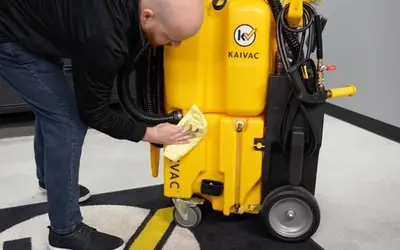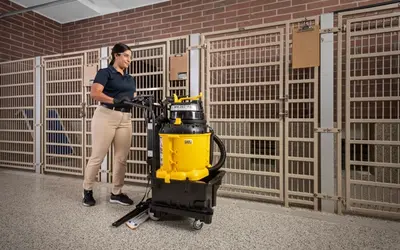Veterinary Cleaning in the Age of Coronavirus: Keeping pets, their owners and employees safe

Clyde missed his annual check-up in early April.
Even though veterinary offices were deemed essential businesses from the start, the haze of freshly minted stay-at-home orders and breaking news that pets and zoo animals can catch SARS-CoV-2, made it seem prudent to put off my 20-pound tabby’s annual exam.
Now that counties in every state are slowly opening up, I rescheduled Clyde’s visit. But going to the vet’s office now will look quite a bit different as new protocols have been announced. Pet parents can expect to see increased use of personal protective equipment (PPE), interiors redesigned to encourage social distancing and enhanced veterinary cleaning in the age of Coronavirus to keep pets, their owners and employees safe.
Pets and Coronavirus: What’s the Risk?
The CDC reports that this novel coronavirus began in animals before spreading to humans. They also report that there have been limited cases of a small number of pets infected with the virus that causes COVD-19 in humans, including a tiger and other large cats at a New York City zoo. Experts think all of these animals were infected by their human caretakers.
(The scientific name of this novel coronavirus is severe acute respiratory syndrome coronavirus 2 (SARS-CoV-2). In people, the disease caused by the virus is called Coronavirus Disease 2019, or COVID-19. In the context of animal health, the disease is referred to as SARS-CoV-2.)
The CDC stresses that risk of animals spreading COVID-19 to people is considered to be low, stating that ‘there is no evidence that viruses, including the virus that causes COVID-19, can spread to people from the skin, fur, or hair of pets.’
This good news should be tempered with the reality that the greatest risk of COVID-19 exposure to veterinarians, their teams and the pubic comes from person-to-person contact, according to the American Veterinary Medical Association.
Strategies to Limit Contact
For the last couple of months, veterinary practices looked very much like medical practices. Sick employees are encouraged to stay home, well employees wear face masks and non-urgent visits and elective procedures have been postponed until regular business activity resumes.
Veterinary practices are also encouraged to further social distancing by:
- Using telemedicine for consults and triage
- Scheduling curbside drop offs and pick ups
- Taking pets directly to the exam room
- Having staff members hold pets during exams
- Using online payment and billing
Cleaning Vet Clinics in the Age of Coronavirus
Cleaning has always played an important role in the safety and success of veterinary practices. Enhanced cleaning protocols will be paramount to safely reopening these clinics and reassuring clients that it is okay to bring their pets in to be seen. While some practices are continuing to offer curbside service, open lobbies will certainly signal a return to normalcy.
Encourage social distancing in open lobbies by removing or blocking seating. And then get to cleaning. Pay special attention to touchpoints like door handles, credit card readers and the entire front desk. Use an EPA-approved disinfectant for vet clinic cleaning and follow manufacturer directions for dilution and dwell time. The same protocol should be followed for exam rooms.
Note that animal feces may be infected with SARS-CoV-2. Because of this animal waste, blood and bodily fluids and any personal protective equipment soiled with this waste must be segregated from normal trash and treated as medical waste. Refer to state and local requirements for proper disposal.
Wear appropriate PPE to contain any animal urine, feces, blood, saliva or vomit. Clean and disinfect the area with an EPA-registered disinfectant and keep people and animals away from the are until the work is completed.
Animal Boarding
Kennels and other vet clinic cleaning areas should receive the same upgraded cleaning protocols. Instruct staff on the best way to clean kennels, stressing that animals must always be removed before the cleaning process begins. Also instruct them to remove food and water bowls, bedding and toys.
Disinfecting should only take place after first cleaning and drying the kennel. Veterinary Practice News lists these other, most common disinfectant mistakes:
- Inadequate contact time
- Using the wrong product around cats
- Not diluting disinfectants properly
- Not rinsing disinfectants
- Risking cross contamination
Making Cleaning Faster and Easier in the Age of Coronavirus
Using typical technology like mops, buckets and rags will slow down enhanced cleaning protocols while increasing the risk of cross contamination. Technologies from Kaivac like the Kaifly system and Smart Towel, however, can cut the risk of cross contamination while speeding up cleaning touchpoints like front desks, door handles and more.
Try one of Kaivac’s Spray-and-Vac cleaning systems for floor, restroom and kennel cleaning. This machine extracts dirt, germs, bacteria and biowaste from all surfaces with a single pass and works about 25% faster than mops.
Related Posts

Preventive Maintenance for Your No-Touch Cleaning® System
Your Kaivac No-Touch Cleaning system makes restroom maintenance fast and easy. Keeping your No-Touch Cleaning system in good working order is also fast and easy. Kaivac makes performing preventative maintenance and troubleshooting potential issues simple. No special equipment or technical expertise required.
Read more
The Best Dog Kennel Cleaning Equipment
There are ways to simplify the kennel cleaning process. Automatic kennel cleaning equipment can simplify the kennel cleaning process and can save hours of daily, back breaking labor–even for facilities without central drains.
Read more
A Better Retail Floor Care Option: How One National Retailer Reclaimed Floor Care
Discover how a national retailer cut costs and improved results by switching to Kaivac’s All Floor™ system—an easy, all-in-one floor care solution perfect for low-revenue retail locations.
Read more